Last Updated on April 12, 2023
The Samoyed breed is best known for its fluffy, white coats.
Affectionately called “Sammies,” these adorable dogs are impervious to the cold and are a truly northern breed. They have a perpetual smile, which earns them the “Smiley” nickname as well.
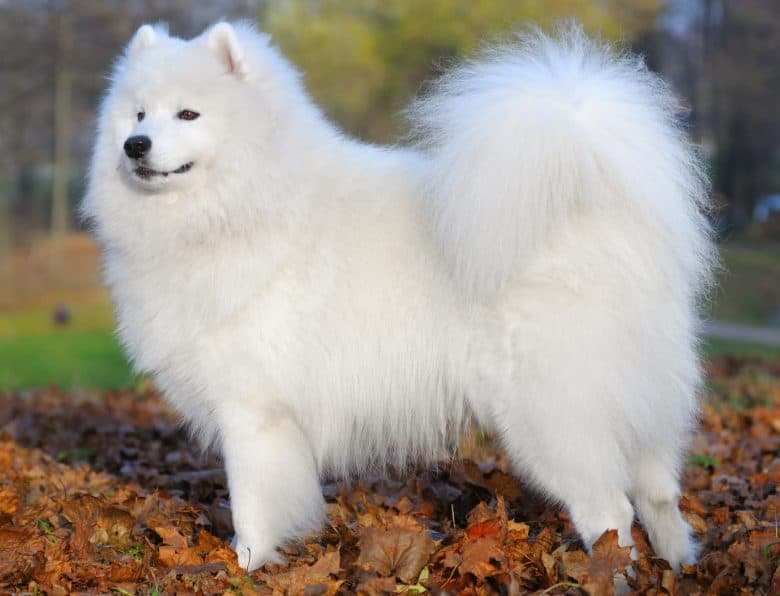
They are mostly companion dogs today, though they are not suitable for everyone. Keep reading to find out if these small, fluffy dogs are right for you.
Quick Navigation
- 1 Where did the Samoyed originate?
- 2 What does a Samoyed dog look like?
- 3 Temperament: Are Samoyed good family dogs?
- 4 Care: Are Samoyed high maintenance?
- 5 What health problems do Samoyed dogs breeds have?
- 6 How much does a Samoyed puppy cost?
- 7 Samoyed compared to other similar breeds
- 8 Who should get a Samoyed dog?
- 9 Reference
Where did the Samoyed originate?
Samoyeds were bred in Siberia, where arctic temperatures of -60 are not necessarily uncommon. For this reason, they have a very thick, impenetrable coat.
The name “Samoyeds” comes from the Samoyede people, who are semi-nomadic in Siberia. This breed is thought to come from this particular group of people.
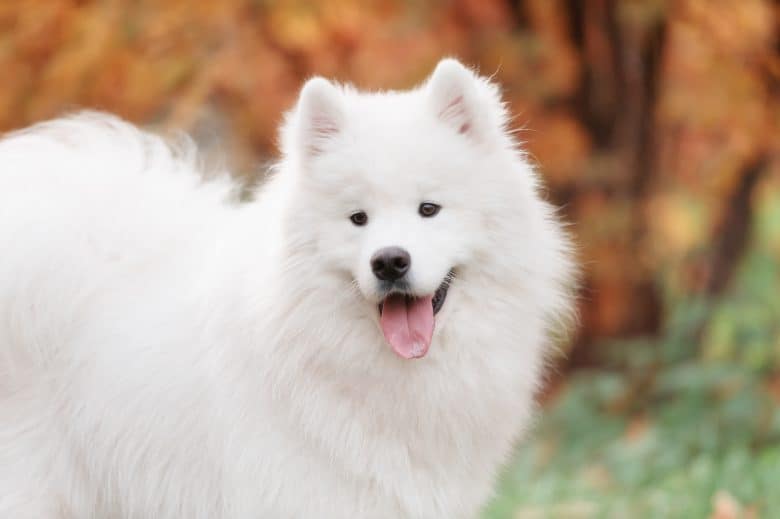
Like Huskies, these dogs were used for sledding. They hailed sleds, people, and equipment across vast lands of ice. They were also used as watchdogs and hunters.
The Samoyede people depended on the reindeer as a source of food and warmth. Sometimes, these dogs were used as herders as well, though this was absolutely their secondary function.
Explorers brought the Samoyed back to England in the late 18th century. They became especially popular after Queen Alexandra took a liking to them.
These dogs were the first canines to be recognized by the American Kennel Club in 1906.
Many explorers in America and Europe used Samoyeds to pull their sleds and haul supplies. Scott, Shackleton, and Amundsen were some of the most famous sledders who used these canines.
While these dogs look like both Huskies and wolves, they do not have the genetics of either in them. They are their own, separate breed, though they are used for similar purposes as a Husky.
What does a Samoyed dog look like?
The Samoyed is recognized by the AKC and has a set breed standard. These dogs are quite squarely built and are very sturdy.
Despite their smaller size, they can hold their own and then some. They have fluffy plumed tails that curl over their back and sometimes drape to one side. Their tail is very similar to that of a Husky’s.
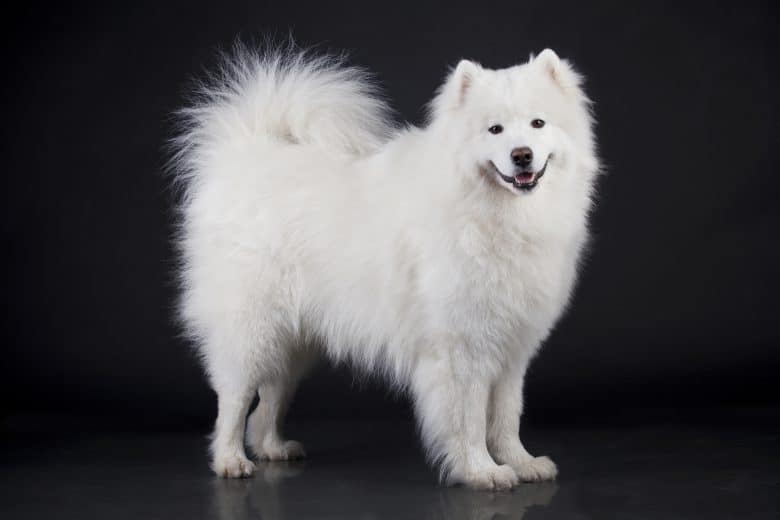
Their legs are moderately long, and their chests are quite deep. Their forequarters are parallel and straight. Their thighs are quite muscular and obviously built for endurance.
Their ears are thick and erect. However, they are not particularly pointy and are rounded at the tips.
They are not small or “bear-eared”. The ears are pretty well set apart but are within the outer border of the head. In other words, they should not stick out to the sides.
The ears are well-covered with hair, which protects them from the outside elements.
They are well known for their “sammie smile”. Their lips curl up and are in an eternal smile.
They also have darkly pigmented faces, including their eyes, nose, and lips. Their black facial features stand out strikingly against their white coats.
Samoyeds do not have blue eyes. Instead, they are typically black or otherwise darkly colored. They have almond-shaped eyes.
They have a very well-muscled neck. In fact, with their muscular build and thick coat, it can almost look like they have no neck at all.
How big does a Samoyed get?
Samoyeds are usually considered to be medium- to large-sized dogs. Males can be between 45-65 pounds (20.4 kg to 29.5 kg), while females can be between 35-50 pounds (15.8 kg to 22.68 kg).
They can stand as tall as 21-23.5 inches (53.34 cm – 59.69 cm) if they are male, though females usually don’t stand more than 19-21 inches (48.26 cm – 53.34 cm) tall.
While males are bigger overall, females are quite a bit longer.
Some breeders advertise “mini Samoyeds”. However, there is no official mini version of this canine.
Any mini-version is really just a result of two smaller dogs or a mixed breed between a Samoyed and a smaller dog. In other words, it is a marketing ploy.
While these dogs were made for the wide-open tundra, they can work fine in an apartment.
As long as they get enough exercise, they can adapt to apartment living. They do not need a huge amount of space.
What color are Samoyed dogs?
These canines are white. They only come in pure white and certain white tones, such as cream and biscuit, though some breeders bill mixed breeds as “black Samoyeds”.
There are no purebred black Samoyeds.
Samoyeds are well-known for their extremely fluffy coat. They have a straight outer coat and a soft, wooly undercoat.
This double coat helps them remain warm in frigid temperatures. They are extremely well-built against the great outdoors.
Their fur hangs quite a ways off of their stomach and flails off of their front legs. Their coats are very feathery.
Temperament: Are Samoyed good family dogs?
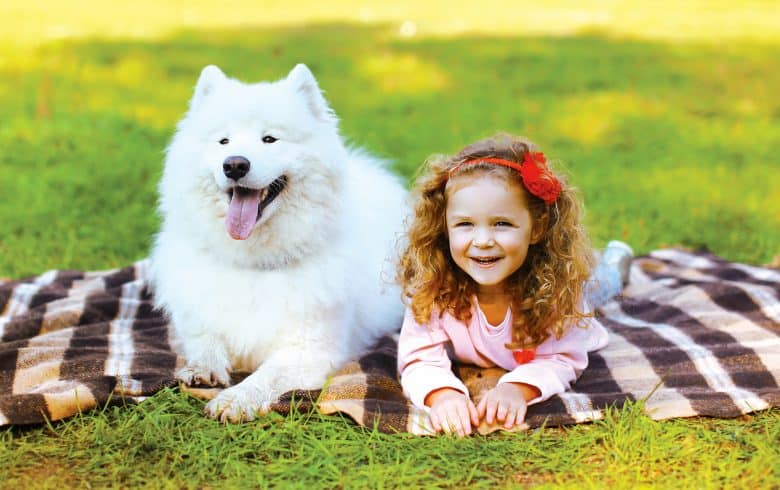
The Samoyed is friendly and personable. They were bred to be around other dogs and people, so they typically get along just fine with other pets.
They tend to be very attached to their people and can have some trouble with separation anxiety.
As herding dogs, these canines sometimes try to herd other animals. However, their instincts are not as strong as some of the other herdings breed out there.
For this reason, they don’t usually herd things as often as other canines. Still, they have some tendency to nip or chase.
They are usually pretty friendly with children and have enough patience for most. However, excitable children can stress them out. They usually do not take well to their fur or ears being pulled.
They are smaller as well, so smaller children can harm them. This can cause them to be fearful, which isn’t good for anyone involved.
These dogs are not lazy by any means, though they are not as excitable as some other breeds. They are decently active and playful, which makes them most suited to active families.
Their energy levels can be quite high. While these dogs are not particularly fast, their endurance levels are quite high. They are working dogs, after all.
Do Samoyed bark a lot?
These canines will alarm bark. Of course, some do it worse than others, so it does depend on the exact dog.
They can develop into nuisance barkers if left alone. Barking at everyone who comes by seems to be one of their favorite ways to pass the time!
It is important to remember that these canines were bred to function as alert dogs. While you can teach them not to bark in certain situations, their first instinct is noisy.
If you cannot put up with a little noise, you should not adopt one of these canines.
Are Samoyed intelligent?
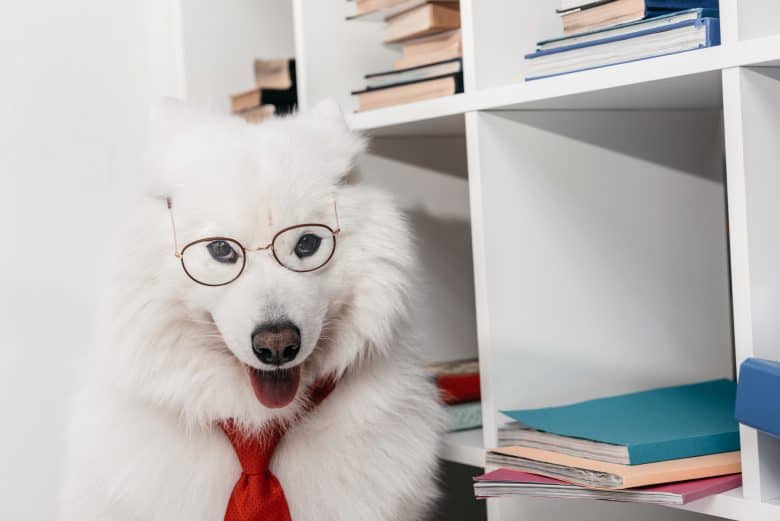
They are brilliant, which can also make them somewhat independent.
When they set their mind to something, they will often find a way to do it – even if it is something you don’t necessarily want them to do. This can make training a bit difficult!
Because these dogs form such a close bond with their people, they tend to train rather easily. However, this close bond also means you cannot leave them alone.
They tend to become destructive. This is not a behavior you can necessarily “train out” either. They just aren’t made for extended periods by themselves.
Do Samoyeds like to swim?
These dogs are not bred to swim. They are not bred for it or physically prepared to do it. They do not have webbed feet or water-proof coats like breeds that were designed for swimming.
However, this doesn’t necessarily mean they won’t like swimming. Some of them enjoy swimming quite a bit. This is more of a question of exposure, though.
If your dog is around water from a young age, they will likely figure out how to swim and may enjoy it.
These dogs do not have an innate love of water, but that doesn’t mean they won’t enjoy swimming.
Care: Are Samoyed high maintenance?
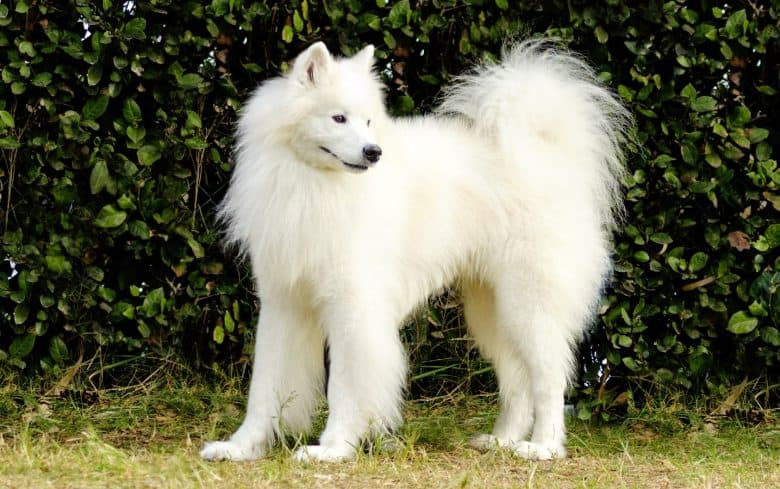
Samoyeds are not some of the most high-maintenance dogs around, but they do require quite a bit of care.
As you might imagine, their coats need to be taken care of regularly. They are also rather active and require a lot of exercise.
They are prone to obesity as well, so they need to be fed very carefully.
Overall, these dogs are best for owners that have plenty of free time to take care of them. In order to stay happy and healthy, they will need their owners to put in quite a bit of work.
Samoyed are built for cold weather, so they generally do fine. Historically, they were bred in areas where it regularly reaches below -60 degrees.
That doesn’t mean you should leave them out in weather that cold, but it does mean that they usually don’t mind moderately cold temperatures.
Despite their adaptation to the cold, the heat doesn’t bother them very much either. Their coat is designed to keep them comfortable in a variety of temperatures, and it works very well in hotter climates.
You should not shave them, as this can actually make them more susceptible to hot weather.
They don’t necessarily thrive in hotter climates, but they shouldn’t have too much of a problem either.
Exercise: How often should you walk a Samoyed?
Samoyed dogs were made to haul sledges and be on their feet all day. They have very high endurance, making daily exercise important.
This means that they need quite a bit of exercise. You should plan on long walks daily.
This can be in the form of a single, longer walk. Alternatively, you could take them on two shorter walks.
Playtime and training are also good exercise opportunities. You can train your dog in canine sports like agility, which will wear out their body and mind.
As these dogs are quite intelligent, they need quite a bit of mental stimulation as well. Training tackles both of these needs at once.
When exercised properly, these dogs don’t need too much space. They are suitable to apartment living – given that they are taken on their daily walks.
They are quite well behaved inside and do not get as excitable as other dogs.
Grooming: Do Samoyeds shed hair?
Yes, these dogs do shed quite a bit. They have long, white hair, which is very apparent on most clothes and furniture. It takes a lot of grooming to keep them looking their best.
While their coats are decently weather-resistant, they will need to be groomed regularly.
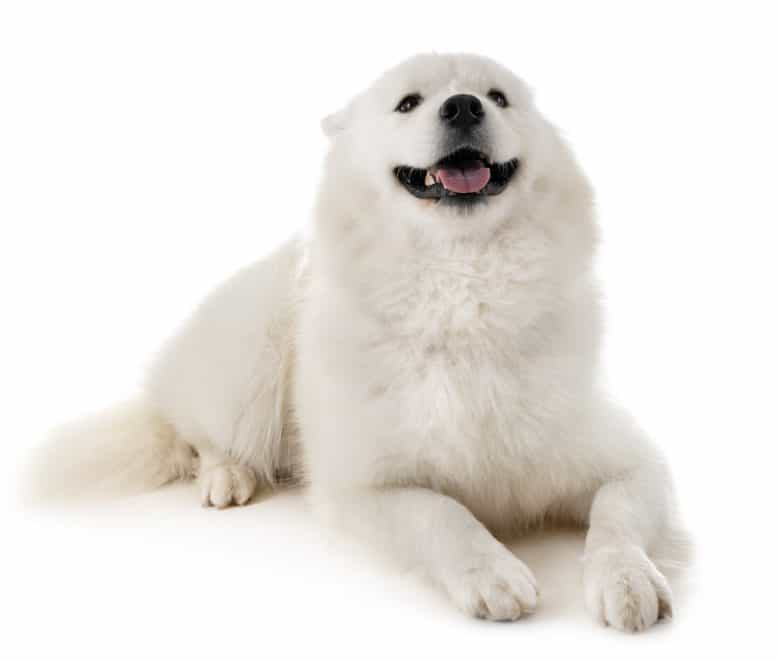
Luckily, these dogs do not need trimmed or cut at all. In fact, it is highly recommended that you don’t trim them, even if you live in a warmer climate.
Cutting their hair can affect how weather-resistant their coat is, making them more susceptible to the heat and cold. Their coats are very well-designed.
These dogs are not hypoallergenic in the least. When someone is allergic to dogs, they are allergic to the dander and saliva of the animal.
All dogs have saliva and dander, even if they don’t shed very much. Therefore, there is really no such thing as a hypoallergenic dog.
The problem is that hair tends to carry dander and saliva further. Samoyeds tend to shed quite a bit, so their dander will be all over the house without a problem.
Therefore, they are particularly unsuitable for homes that include someone sensitive to dogs.
While these dogs shed all the time, they shed particularly bad a few times a year as the seasons change. They will need extra care during these periods.
Here is a video describing how to properly groom your Samoyed at home.
How to Groom a Samoyed Dog?
Firstly, these dogs will need to be brushed regularly. You should plan to brush them at least every other day, though everyday is probably the best option if you have the time.
A slicker brush and a metal comb work the best.
These tools help your each the wooly undercoat, which is where most of the shedded hair comes from.
The metal comb is perfect for getting debris out of the dog’s coat. Their profuse fur can easily snag twigs, leave, and brambles.
While grooming, remember to brush their legs and head as well. While these areas have less fur than other parts of the body, they are quite floofy. These locations need brushing as well.
Like all dogs, you will need to trim their nails as well. Overgrown nails can not only hurt you and your belongings, but they are painful for your dog as well.
Whenever your brush your dog, give a quick glance to their nails.
You should also trim the hair in between your dog’s paw pads. This will help them find more stability on our modern, often-slick floors.
If you have hardwood floors or tile in your home, this is even more important. The last thing you need is a slippery dog.
Bathing these dogs is particularly tricky.
Their undercoat is not designed to get wet. Instead, their overcoat does a pretty good job of keeping them warm and dry. However, this can complicate things when it comes time for a bath.
Once it is wet, their undercoat does not dry fast at all. It can stay wet for a day or more. Often, you may not even notice, as their overcoat will hide the dampness of their undercoat.
However, this wet fur can severely irritate and dry out your pet’s skin. It can cause hot spots and all sorts of other issues. To avoid this, they do need to be blowdried thoroughly.
The easiest way to do this is to take them to a groomer whenever they need a bath. You can also keep a dog-safe hair dryer at home for those muddy days.
Luckily, these dogs do not need baths very often. Unless they are visibly dirty, they likely don’t need a bath.
Brushing your dog regularly will keep them rather clean, as the brush will help remove dirt and such alongside dead hair.
How much should a Samoyed eat in a day?
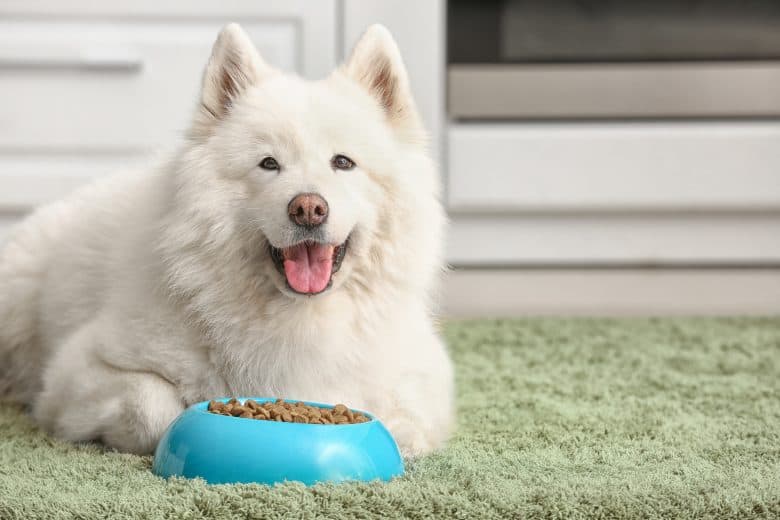
These dogs are prone to obesity, so it is important to feed them the correct amount. They need about 1 cup to 1.5 cups of dog food a day.
Males will need more than females, as they are larger. Females really will not increase their intake very much from puppyhood.
These dogs benefit from added fish oil and omega fatty acids to their diet, as these promote a healthy coat.
Let’s be honest. The Samoyed’s coat is extremely fluffy and a major part of their wellbeing. Their coat should be well taken care of, and their diet plays a significant role in this.
The Samoyed is prone to obesity, especially if they do not get enough exercise. You should keep an eye on their body condition and be prepared to change the amount of food (or exercise) they get.
What health problems do Samoyed dogs breeds have?
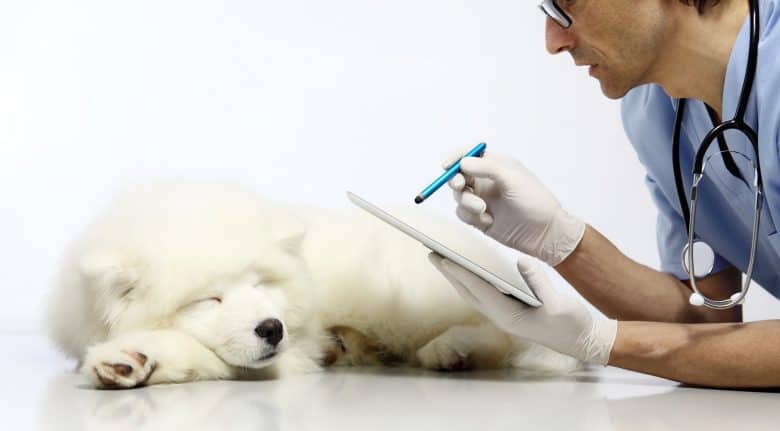
Like all canines, Samoyed dogs are prone to a few different health issues, some of which can affect them from an early age. We’ll discuss all the health problems these dogs are prone to develop.
Eye Problems
The Samoyed breed is prone to some eye problems, including glaucoma and progressive retinal atrophy.
Glaucoma is caused when the fluid of the eye does not drain properly. This causes pressure problems, which can damage the retina and optic nerve. Eye pain is the most obvious sign of this disorder.
Your dog may rub his eye or become protective of that area. Watery discharge, loss of appetite, and lethargy are common as well.
In severe cases, there may be a significant amount of swelling and bulging of the eye ball. Blindness can occur very quickly.
Acute glaucoma and chronic glaucoma can both occur. Acute glaucoma sets in very quickly, while chronic glaucoma is much slower.
Glaucoma is treatable with medication.
Progressive retinal atrophy, or PRA, is a genetic disorder that involves the wasting of the photoreceptor cells in the eye.
Eventually, this leads to blindness. There is both an early onset form and a late onset form.
This is an inherited disease. For a puppy to get it, they have to inherit it from one of their parents. The easiest way to avoid it, then, is to not breed dogs with this eye problem.
This is another reason to only adopt from qualified breeders who perform health testing.
Joint Problems
Many dogs are prone to joint problems, and the Samoyed is no different. They are prone to both hip dysplasia and patellar luxation. Both of these affect the joints and have varying degrees of severity.
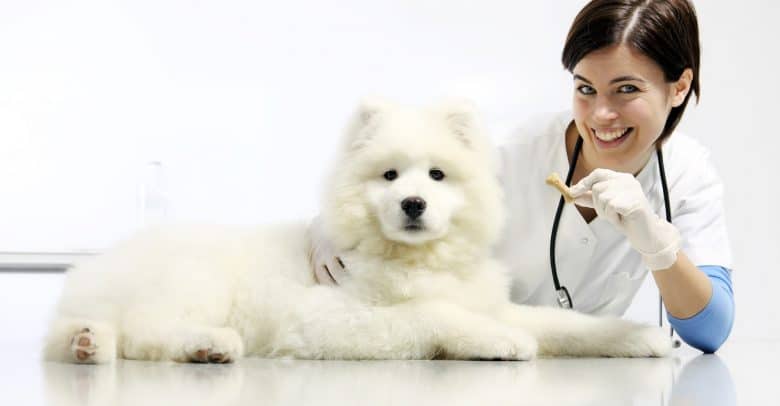
Hip dysplasia is a deformation of the hip socket. The ball and the socket do not develop at the same rate, which eventually causes them not to fit into each other.
This can cause a degree of lameness.
Some dogs have very minor hip dysplasia, while others have significantly worse hip dysplasia.
This is another genetic condition. Dogs with hip dysplasia may pass it onto the puppies. Be sure any breeder you adopt from performs the appropriate health testing on all their breeding dogs.
While there is no cure for this condition, it can be treated with medication. It tends to worsen with age as the bones continue to wear down.
Patellar luxation is another common joint problem. This involves the dislocation of the knee cap.
It is one of the most common orthopedic conditions that affect dogs. It is diagnosed in up to 7% of all dogs according to ACVS.
This can happen out of nowhere or it can be caused by a traumatic injury. Either way, surgery is required to put the knee cap back into the correct location.
Samoyed Hereditary Glomerulopathy
As the name suggests, this is a hereditary condition that just affects Samoyeds. It is sex-linked and appears on the X chromosome.
Therefore, males are usually affected more often, as females have a “back-up” X chromosome. Males usually have more severe symptoms as well.
At around four months of age, both genders will develop proteinuria. This involves an excess amount of protein in their urine.
This disorder will lead to kidney failure when the dog is between 8 to 15 months. Death is expected, as there is no cure for this disease.
Females usually die later as the disease progresses slower. Makes are usually more gravely affected.
Medication can slow the progression of the disease, but it cannot be stopped completely.
Other Health Problems
On top of these more common problems, there are a few other health conditions that these dogs are prone to as well.
Hypothyroidism is somewhat common. It involves the thyroid gland being underactive, which can cause all sorts of different symptoms. Weight loss, hair loss, and skin changes are all common.
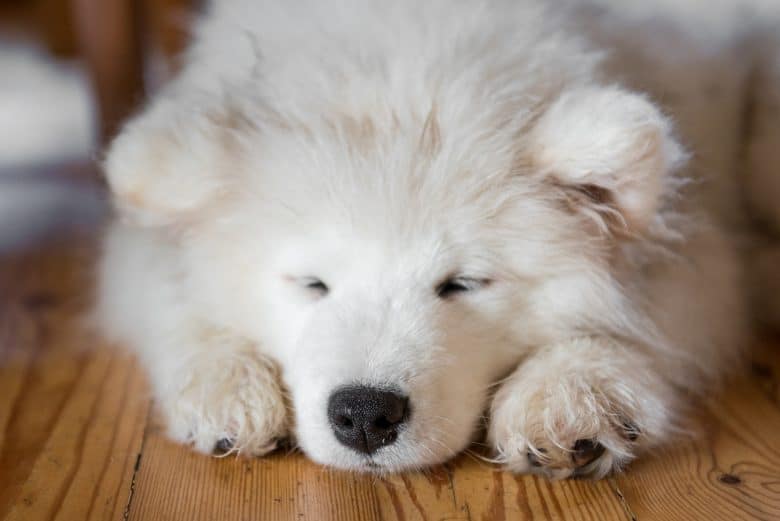
This problem is not completely curable. However, the dogs can be given a replacement thyroid hormone orally, which will fix their symptoms.
It can be managed with the correct medication, but the dogs will be on this medication for the rest of their life. Blood samples are important to ensure that the medication is working.
Diabetes mellitus is another condition that the Samoyed is somewhat prone to. This condition is characterized by the inability of the pancreas to regulate blood sugar.
The four main symptoms including thirst, increased urination, weight loss, and increased appetite.
There are a few different types of diabetes, but they are all associated with the same treatment and symptoms.
Nutrition is important for the management of this disease. Dogs should continue to eat the correct diet and may even need to switch to better dog food.
Most dogs will need to take insulin daily for the rest of their lives. Typically, though, because dog’s diet are generally the same each day, this condition is easy to regulate.
Subvalvular aortic stenosis is the narrowing of the aortic valve in the heart. This causes circulation problems and increases the amount of work your dog’s heart has to do.
Most dogs are not affected much by this disease. In many cases, no symptoms are present.
Symptoms are usually not apparent until later stages of the disease. Treatment is not always required, but long-term medication may be needed in severe cases.
Cancer is sometimes common as well. Of course, there are many different kinds of cancer and the treatment is dependent on the cancer type and severity.
What is the average lifespan of a Samoyed?
The average Samoyed lives about 12 – 14 years. The exact life expectancy of a dog is dependent on their overall health, diet, exercise, and lifestyle.
These dogs live a moderately long time, especially for the medium-sized dogs they are.
How much does a Samoyed puppy cost?
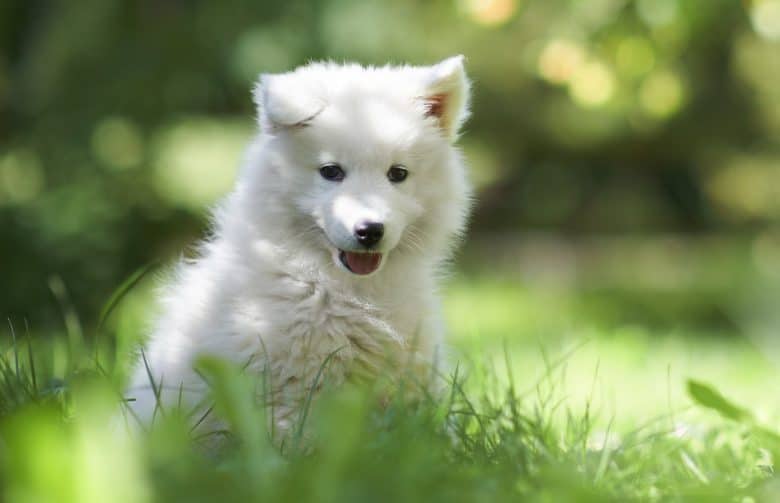
Samoyed puppy usually costs between $600 to $1500. However, award-winning bloodlines and show dogs are typically much more expensive. Some dogs can cost up to $3000.
This is about average in purebred standards. However, they are not cheap by any means. They are one of the most expensive dogs.
You also have to consider the costs associated with raising these dogs. They generally require quite a bit of food, as they are medium-sized dogs.
They are usually pretty healthy, but age-related health problems are quite likely.
Be sure you have plenty of money to take care of a Samoyed properly before adopting one.
Samoyed Breeders
The easiest place to find a breeder is to check the Samoyed Club of America. They have listings for breeders from a variety of regions. All breeders on this page must keep certain standards.
There are actually many different breeders out there – more than you would probably guess for a rarer breed.
Many people will have access to many different breeders in their area. You may be able to choose between multiple breeders.
Some of the most popular breeders include Magic White Samoyed, Kabeara Samoyeds, and Polar Mist Samoyeds.
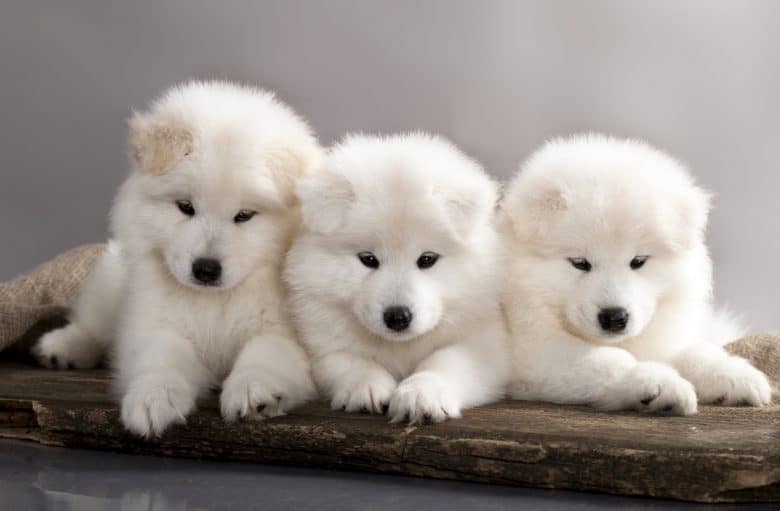
Samoyed Rescue
The Samoyed Club of America also has a listing for their approved rescue groups. There are quite a few rescues across the United States, so there is likely one that caters to your family.
If you’re looking for a Samoyed in particular, these groups can likely help.
You may also be able to find Samoyeds at your local animal shelters and other local rescue organizations.
Some local organizations include the San Francisco Samoyed Rescue and Northern Illinois Samoyed Assistance. You can also check the National Samoyed Rescue, which rescues dogs in the United States
Samoyed compared to other similar breeds
There are a few different breeds that the Samoyed is very similar to – so much so that they sometimes get confused for them.
American Eskimo dog vs. Samoyed
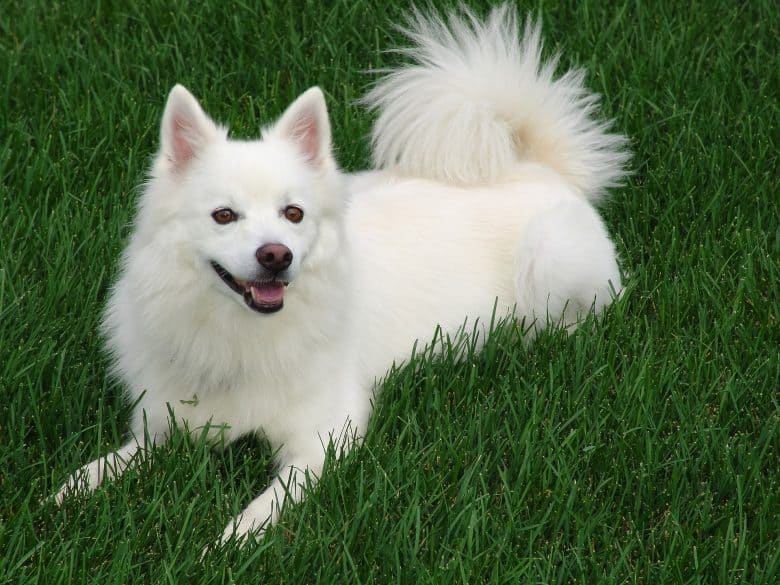
American Eskimos and Samoyeds look very similar. They have beautiful, flowing white coats.
However, American Eskimo dogs are significantly smaller and have smaller heads. They look very similar to Pomeranians, but with a white coat.
They also tend to act more like toy dogs than Samoyeds. They are quite excitable and will follow you from room to room.
Siberian Husky vs. Samoyed
Siberian Huskies are usually a little bit bigger than Samoyeds. However, they are both medium-sized dogs.
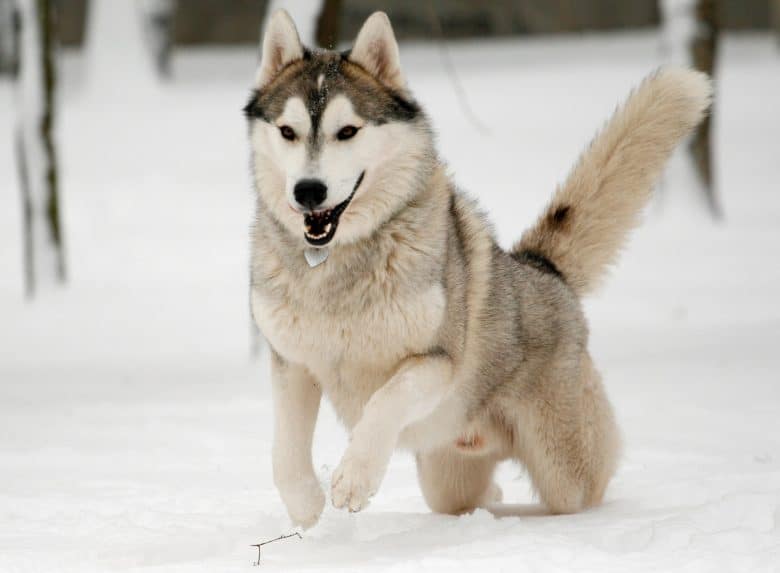
Samoyeds have some herding instincts, while Siberian Huskies do not. They may try to herd small children, but Siberian Huskies will never do this.
They are about as equally healthy, as they are both prone to similar diseases.
Japanese Spitz vs. Samoyed
The Japanese Spitz is smaller than a Samoyed by quite a bit. They are more similar to a Pomeranian or American Eskimo than a Samoyed.
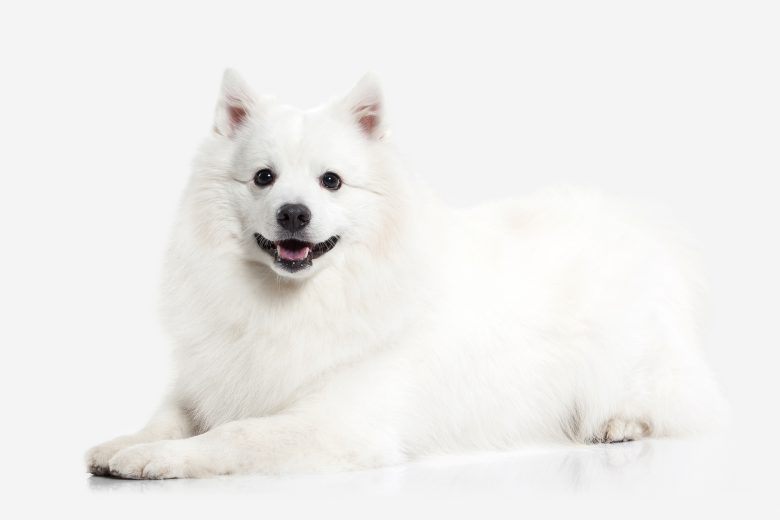
Japanese Spitz also doesn’t need as much exercise. They only need about an hour of exercise a day, while Samoyeds need more.
Who should get a Samoyed dog?
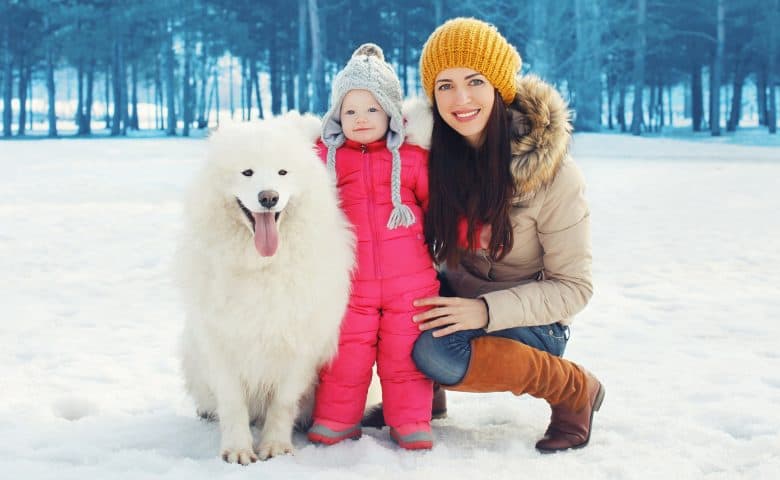
Samoyed dogs are best for active owners who have quite a bit of extra time on their hands. They require quite a bit of exercise and a decent amount of training and attention.
They are suitable for large and small families.
They are often good with children and other animals. As pack dogs, they are friendly around other dogs as well. Therefore, if you have other canines, this may be a good pet to add to your pack.
Do you have a Samoyed dog? Let us know if we hit the nail on the head in this article in the comments below!
Reference
- https://images.akc.org/pdf/breeds/standards/Samoyed.pdf
- https://www.acvs.org/small-animal/patellar-luxations#:~:text=Patellar%20luxation%20(dislocation)%20is%20a,aspect%20of%20the%20knee%20respectively.
- https://vcahospitals.com/know-your-pet/diabetes-mellitus-in-dogs-overview
Cess is the Head of Content Writing at K9 Web and a passionate dog care expert with over 5 years of experience in the Pet Industry. With a background in animal science, dog training, and behavior consulting, her hands-on experience and extensive knowledge make her a trusted source for dog owners.
When not writing or leading the K9 Web content team, Cess can be found volunteering at local shelters and participating in dog-related events.
